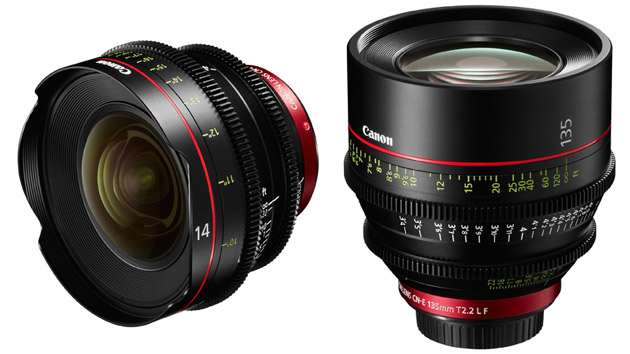News
Canon announces two new fixed lenses
Last week Canon announced two new additions to its Cinema EOS System. These are two EF-mount prime lenses, the CN-E14mm T3.1 L F and the CN-E135mm T2.2 L F, which expand the product lineup at both ends of the focal length spectrum (wide angle and telephoto).
Now that the company has gotten a little bit bigger it has five fixed lenses and four zooms (the latter with EF and PL mount versions), all designed for the 4K capture that is establishing itself as a production standard.
Fixed lenses
 CN-E24mm T1.5 L F
CN-E24mm T1.5 L F
CN-E50mm T1.3 L F
CN-E85mm T1.3 L F
Zoom lenses
High Range:
CN-E 14.5-60mm T2.6
CN-E 30-300mm T2.95-3.7
Compact:
CN-E15.5-47mm T2.8
CN-E30-105mm T2.8
All Canon Cinema EOS lenses integrate advanced materials and coatings for 4K (4096 x 2160) compliance. Each is equipped with 11 diaphragm aperture blades, ideal for manipulating depth of field and achieving cinematic effects. In addition, the five fixed lenses have been designed to match the color tone and balance of the zooms.
Thanks to their full-frame image circle, both prime and zoom lenses are compatible with cameras using Super 35mm or full frame 35mm formats.
Although users could use the EF-mount lenses of their still cameras, these have been designed for working with moving images, including attributes such as 300 degrees of focus ring rotation, focus assist options, etc. They also feature electrical contacts that enable communication between the camera and lenses, allowing f-stops to be displayed on the viewfinder, recording of focus and zoom positions and f-number, and (in upcoming firmware updates) peripheral illumination compensation for image processing.
Since the company decided to enter the film and television production industry, in addition to all the lenses mentioned above, in the last 18 months they have also released the EOS C500 (4K/2K), EOS C300, EOS C100 and EOS-1D C digital cameras (which are part of the EOS Cinema System and are compatible with the new lenses).
Because the lenses share the same gear design, diameters and rotation angles, they are compatible with multiple third-party accessories, allowing them to be interchanged without the need to reconfigure the entire camera rig.
Canon has continued its development to meet high levels of optical performance, precision, a variety of focal lengths and competitive pricing to enable its users to achieve their creative and commercial desires.
The CN-E14mm is expected to be available in April 2013 for an estimated price of $5,500; followed by the CN-E135mm arriving in May for $5,200.
If you want more information about Canon lenses you can check this page.


